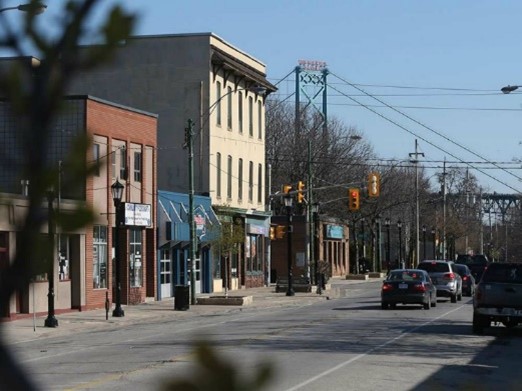Over the past 110 years, the Brighton Beach landscape has changed significantly. With the exception of a few privately-owned homes, the area had been all but abandoned from residential use for many years. Many of the properties had become overgrown and as because of accessibility and poor lighting, the vacant lots became vulnerable to illegal dumping. The scene is now dramatically different.
Species at Risk SAR relocation
In 1999, following four years of technical studies, community consultation and planning, Canada announced the approval of the federal environmental assessment for the Canadian plaza and portion of the bridge. The decision required that there be sound and responsible environmental management of the project site and that appropriate mitigation be undertaken to ensure that the project would not result in any significant environmental effects.
To determine the number of Species at Risk (SAR) on the site, a comprehensive survey was conducted and the locations of all SAR vegetation were mapped. Breeding bird surveys, snake “coverboard” surveys, as well as an inventory of all tress greater than 10 centimetres diameter at their breast height were also conducted. Once the field investigations were completed, the complete site was mowed in order to dissuade wildlife from using the site for habitat.
The surveys detected the presence of two SARS vegetation – the Dense Blazing Star and the Willowleaf Aster as well as two SAR snakes – the Butler’s Gartersnake and the Eastern Foxsnake as being on the site. In addition, a large area of tall grass prairie, a non-SARS vegetation, was located on the site. Tall grass prairie is an important ecosystem native to central North America and supports reptiles, birds and butterflies.
Starting in 2012 and prior to the initiation of further site preparation and construction, environmental mitigation began with the relocation of approximately 2,100 SAR plants and 3,000 square metres of tallgrass prairie sod mats to be transplanted in a suitable habitat.
In 2013, 1,200 metres of snake fencing was installed around the perimeter of the site. The fencing ensured that any SAR snakes on the site were isolated and that other snakes or wildlife would not enter the area. Snake “cover boards” were used on the site to provide an artificial shelter for the snakes. All captured snakes, both SARS and non-SARS, were moved to a conservation area.
Waste removal
Property clearance is no easy task and the arduous job is best left to professionals such as local company, Columbia Utility Services Inc., which started waste removal from the site in June, 2014. Over the next three months, more than 902 metric tons of waste was removed from what was once one of the city’s biggest illegal dumping hotspots.
The work included some interesting finds. During the clearance, workers found what was first thought to be a soil mound but was discovered to be a small home which had collapsed and over time was entombed in vegetation. It still fluid furniture, a kitchen stove as well as other household items. Three abandoned and unusable boats were recovered as well as almost ten tons of tires, over six tons of asbestos and more than two tons of hazardous waste.
The waste removal contract specified that as much material as possible was to be diverted from traditional landfill sites. As a result, more than 131 metric tons of waste including wood, concrete and metal products, tires, and E-waste was recycled.
Tree and shrub removal
Starting in October 2014 and ending in January of the following year, the third stage of the clearance activities on the plaza site was conducted. This phase included the removal of trees and brush however no sub-surface work was completed and, as such, all tree stumps were ground to grade with their root structure left in place.
Extensive measures were taken to ensure that any remaining animal and vegetation Species at Risk were protected during the project. Work in areas that may still contain Species at Risk plants was conducted in mid-November when the plants would be in a dormancy state and therefore any damage or disturbance would be minimized. The work was also conducted within a fenced area so that wildlife and Species at Risk animals would not move into the project area.
The contract specified that the vegetation must be sorted and that as much material as possible was to be diverted from the waste stream. All non-furniture grade tree logs and brush were stockpiled, chipped onsite and then sent for recycling. Furniture grade logs were sent to an off-site mill. Ultimately, of the 3,100 trees (with a diameter of at least 10 cm) that were removed, more than 400 logs were recovered for furniture manufacture, 200 logs were sold for firewood and the remainder were chipped for landscape use.
Next Steps
As WDBA continues to prepare for construction, and environmental mitigation and protection will continue to an important part of remaining site preparation activities.




